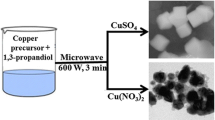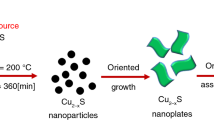Abstract
Copper has attracted considerable interest due to its significant potential for a wide range of applications. The synthesis of copper (Cu) nanoparticles is tedious as they are prone to oxidize even in atmospheric conditions. Surfactant-free microwave-assisted synthesis of Cu microstructures with different morphologies has been accomplished here in the presence of only an antioxidant (ascorbic acid). The size and morphology of the synthesized Cu microstructures were varied by tuning the microwave power, reaction time and concentration of ascorbic acid. Oligoclusters of Cu were isolated through an optimized post-synthesis processing step, and investigations over a period of months of XRD data revealed remarkable stability against oxidation of the synthesized microstructures. TEM and other morphological analyses support a detailed and comparative study on the influences of MW irradiation as well as of the different concentrations of reducing agent, from which metrics for the synthesis of stable Cu microstructures have been established.






Similar content being viewed by others
References
Ren X, Chen D, Tang F (2005) Shape-controlled synthesis of copper colloids with a simple chemical route. J Phys Chem B. https://doi.org/10.1021/jp052374q
Barrière C, Piettre K, Latour V, Margeat O, Turrin CO, Chaudret B, Fau P (2012) Ligand effects on the air stability of copper nanoparticles obtained from organometallic synthesis. J Mater Chem. https://doi.org/10.1039/c2jm14963j
Tanabe K (2007) Optical radiation efficiencies of metal nanoparticles for optoelectronic applications. Mater Lett. https://doi.org/10.1016/j.matlet.2007.02.053
Ren X, Meng X, Tang F (2005) Preparation of Ag-Au nanoparticle and its application to glucose biosensor. Sens Actuators B Chem. https://doi.org/10.1016/j.snb.2005.02.016
Quidant R, Girard C, Weeber JC, Dereux A (2004) Tailoring the transmittance of integrated optical waveguides with short metallic nanoparticle chains. Phys Rev B - Condens Matter Mater Phys. https://doi.org/10.1103/PhysRevB.69.085407
Linic S, Christopher P, Xin H, Marimuthu A (2013) Catalytic and Photocatalytic Transformations Geometric and Plasmonic Properties. Acc Chem Res. https://doi.org/10.1021/ar3002393
Wang B, Zhu X, Li S, Chen M, Liu N, Yang H, Ran M, Lu H, Yang Y (2019) Enhancing the photovoltaic performance of perovskite solar cells using plasmonic Au@Pt@Au core-shell nanoparticles. Nanomat. https://doi.org/10.3390/nano9091263
Huang X, El-Sayed MA (2010) Gold nanoparticles: optical properties and implementations in cancer diagnosis and photothermal therapy. J Adv Res. https://doi.org/10.1016/j.jare.2010.02.002
Keerthana L, Ahmad Dar M, Dharmalingam G (2021) Plasmonic Au-Metal oxide nanocomposites for high-temperature and harsh environment sensing applications. Chem - Asian J. https://doi.org/10.1002/asia.202100885
Dar MI, Sampath S, Shivashankar SA Microwave-assisted surfactant-free synthesis of air-stable copper nanostructures and their SERS study. J Mater Chem. https://doi.org/10.1039/c2jm35629e
Wang J, Zhao X, Tang F, Li Y, Yan Y, Li L (2021) Synthesis of copper nanoparticles with controllable crystallinity and their photothermal property. Colloids Surf Physicochem Eng Asp. https://doi.org/10.1016/j.colsurfa.2021.126970
Zhang X, Zhang D, Ni X, Zheng H (2006) One-step preparation of copper nanorods with rectangular cross sections. Solid State Commun. https://doi.org/10.1016/j.ssc.2006.06.042
Akar N, Asar B, Dizge N, Koyuncu I (2013) Investigation of characterization and biofouling properties of PES membrane containing selenium and copper nanoparticles. J Memb Sci. https://doi.org/10.1016/j.memsci.2013.02.012
Ahmed J, Trinh P, Mugweru AM, Ganguli AK (2011) Self-assembly of copper nanoparticles (cubes, rods and spherical nanostructures): significant role of morphology on hydrogen and oxygen evolution efficiencies. Solid State Sci. https://doi.org/10.1016/j.solidstatesciences.2011.03.005
Ponce AA, Klabunde KJ (2005) Chemical and catalytic activity of copper nanoparticles prepared via metal vapor synthesis. J Mol Catal Chem. https://doi.org/10.1016/j.molcata.2004.08.019
Vilar-Vidal N, Blanco MC, López-Quintela MA, Rivas J, Serra C (2010) Electrochemical synthesis of very stable photoluminescent copper clusters. J Phys Chem C. https://doi.org/10.1021/jp911380s
Lisiecki I, Pileni MP (1993) Synthesis of copper metallic clusters using reverse micelles as Microreactors. J Am Chem Soc. https://doi.org/10.1021/ja00063a006
Raspolli Galletti AM, Antonetti C, Marracci M, Piccinelli F, Tellini B (2013) Novel microwave-synthesis of Cu nanoparticles in the absence of any stabilizing agent and their antibacterial and antistatic applications. Appl Surf Sci. https://doi.org/10.1016/j.apsusc.2013.05.035
Logutenko OA, Titkov AI, Vorobyov AM, Lyakhov NZ (2021) A novel method to prepare copper microspheres via chemical reduction route. J Mater Res Technol. https://doi.org/10.1016/j.jmrt.2021.05.046
Zhao Y, Zhu JJ, Hong JM, Bian N, Chen HY (2004) Microwave-induced polyol-process synthesis of copper and copper oxide nanocrystals with controllable morphology. Eur J Inorg Chem. https://doi.org/10.1002/ejic.200400258
Guzman A, Arroyo J, Verde L, Rengifo J (2015) Synthesis and Characterization of Copper Nanoparticles/Polyvinyl Chloride (Cu NPs/PVC) Nanocomposites. Procedia Mater Sci. https://doi.org/10.1016/j.mspro.2015.04.038
Rajesh KM, Ajitha B, Ashok Kumar Reddy Y, Suneetha Y, Sreedhara Reddy P (2016) Synthesis of copper nanoparticles and role of pH on particle size control. Mater. Today Proc. https://doi.org/10.1016/j.matpr.2016.04.100
Granata G, Yamaoka T, Pagnanelli F, Fuwa A (2016) Study of the synthesis of copper nanoparticles: the role of capping and kinetic towards control of particle size and stability. J Nanoparticle Res. https://doi.org/10.1007/s11051-016-3438-6
Sreeju N, Rufus A, Philip D (2016) Microwave-assisted rapid synthesis of copper nanoparticles with exceptional stability and their multifaceted applications. J Mol Liq. https://doi.org/10.1016/j.molliq.2016.06.080
Din MI, Rehan R (2017) Synthesis, characterization, and applications of copper nanoparticles. Anal Lett. https://doi.org/10.1080/00032719.2016.1172081
Lee YJ, Kim K, Shin LS, Shin KS (2020) Antioxidative metallic copper nanoparticles prepared by modified polyol method and their catalytic activities. J Nanoparticle Res. https://doi.org/10.1007/s11051-019-4727-7
Michaud T, Nobre SS, Baffie T, Pelissier N, Simonato JP (2019) High-temperature stability of copper nanoparticles through Cu@Ag nanostructures. J Nanoparticle Res. https://doi.org/10.1007/s11051-019-4567-5
Tantubay S, Mukhopadhyay SK, Kalita H, Konar S, Dey S, Pathak A, Pramanik P (2015) Carboxymethylated chitosan-stabilized copper nanoparticles: a promise to contribute a potent antifungal and antibacterial agent. J Nanoparticle Res. https://doi.org/10.1007/s11051-015-3047-9
Wu S (2007) Preparation of fine copper powder using ascorbic acid as reducing agent and its application in MLCC. Mater Lett. https://doi.org/10.1016/j.matlet.2006.06.068
Yadav S, Shrivas K, BajpaiP K (2019) Role of precursors in controlling the size, shape and morphology in the synthesis of copper sulfide nanoparticles and their application for fluorescence detection. J Alloys Compd. https://doi.org/10.1016/j.jallcom.2018.08.132
Long B, Cheng S, Ye D, Yue C, Liao J (2019) Mechanistic aspects of preheating effects of precursors on characteristics of Cu 2 ZnSnS 4 (CZTS) thin films and solar cells. Mater Res Bull. https://doi.org/10.1016/j.materresbull.2019.03.027
Liao XH, Wang H, Zhu JJ, Chen HY (2001) Preparation of Bi2S3 nanorods by microwave irradiation. Mater Res Bull. https://doi.org/10.1016/S0025-5408(01)00734-6
Yu Y, Zhao Y, Huang T, Liu H (2010) Microwave-assisted synthesis of palladium nanocubes and nanobars. Mater Res Bull. https://doi.org/10.1016/j.materresbull.2009.09.028
Wei G, Qin W, Zhang D, Wang G, Kim R, Zheng K, Wang L (2009) Synthesis and field emission of MoO3 nanoflowers by a microwave hydrothermal route. J Alloys Compd. https://doi.org/10.1016/j.jallcom.2009.03.007
Dang TMD, Le TTT, Fribourg-Blanc E, Dang MC (2011) Synthesis and optical properties of copper nanoparticles prepared by a chemical reduction method. Adv Nat Sci Nanosci Nanotechnol. https://doi.org/10.1088/2043-6262/2/1/015009
Han KN, Kim NS (2009) Challenges and opportunities in direct write technology using nano-metal particles. KONA Powder Part J. https://doi.org/10.14356/kona.2009009
Zheng X (2008) Controlling synthesis of copper nanorods and triangular nanoplates. J Nano Res. https://doi.org/10.4028/www.scientific.net/JNanoR.4.145
Kanninen P, Johans C, Merta J, Kontturi K (2008) Influence of ligand structure on the stability and oxidation of copper nanoparticles. J Colloid Interface Sci. https://doi.org/10.1016/j.jcis.2007.09.069
Liu X, Zhou Y (2005) Electrochemical synthesis and room temperature oxidation behavior of Cu nanowires. J Mater Res. https://doi.org/10.1557/JMR.2005.0288
Umer A, Naveed S, Ramzan N, Rafique MS, Imran M (2014) A green method for the synthesis of copper nanoparticles using l-ascorbic acid. Rev Mater. https://doi.org/10.1590/S1517-70762014000300002
Baishya K, Idrobo JC, Öǧüt S, Yang M, Jackson KA, Jellinek J (2011) First-principles absorption spectra of Cun (n = 2–20) clusters. Phys Rev B - Condens Matter Mater Phys. https://doi.org/10.1103/PhysRevB.83.245402
Tan M I S M H, Omar AF, Rashid M, Hashim U (2019) VIS-NIR spectral and particles distribution of au, Ag, Cu, Al and Ni nanoparticles synthesized in distilled water using laser ablation. Results Phys. https://doi.org/10.1016/j.rinp.2019.102497
AthawaleA A, Katre PP, KumarM, Majumdar MB (2005) Synthesis of CTAB-IPA reduced copper nanoparticles. Mater Chem Phys. https://doi.org/10.1016/j.matchemphys.2004.12.017
Jain S, Jain A, Kachhawah P, Devra V (2015) Synthesis and size control of copper nanoparticles and their catalytic application. Trans Nonferrous Met Soc China (English Ed). https://doi.org/10.1016/S1003-6326(15)64048-1
Ebnalwaled AA, Said AH, Mahmoud MM, YasserAlsedfy M (2022) XRD and FTIR of ascorbic acid and Monosodium Glutamate Food Additives. Int J Res Publ Rev. https://doi.org/10.55248/gengpi.2022.3.10.1
Menamo DS, Ayele DW, Ali MT (2017) Green synthesis, characterization and antibacterial activity of copper nanoparticles using L-ascorbic acid as a reducing agent. Ethiop J Sci Technol. https://doi.org/10.4314/ejst.v10i3.5
Acknowledgements
The author gratefully acknowledges funding received from Peelamedu Samanaidu Govindasamy Sons’ and Charities organisation for supporting this publication.
Author information
Authors and Affiliations
Corresponding author
Ethics declarations
Conflict of interest
The authors have no conflict of interest to declare.
Additional information
Publisher’s Note
Springer Nature remains neutral with regard to jurisdictional claims in published maps and institutional affiliations.
Electronic Supplementary Material
Below is the link to the electronic supplementary material.
Rights and permissions
Springer Nature or its licensor (e.g. a society or other partner) holds exclusive rights to this article under a publishing agreement with the author(s) or other rightsholder(s); author self-archiving of the accepted manuscript version of this article is solely governed by the terms of such publishing agreement and applicable law.
About this article
Cite this article
Indhu, A.R., Dharmalingam, G. Microwave Prepared Oxidation Resistant Cu Microstructures with Tailored Morphologies. Chemistry Africa (2024). https://doi.org/10.1007/s42250-024-00918-1
Received:
Accepted:
Published:
DOI: https://doi.org/10.1007/s42250-024-00918-1




